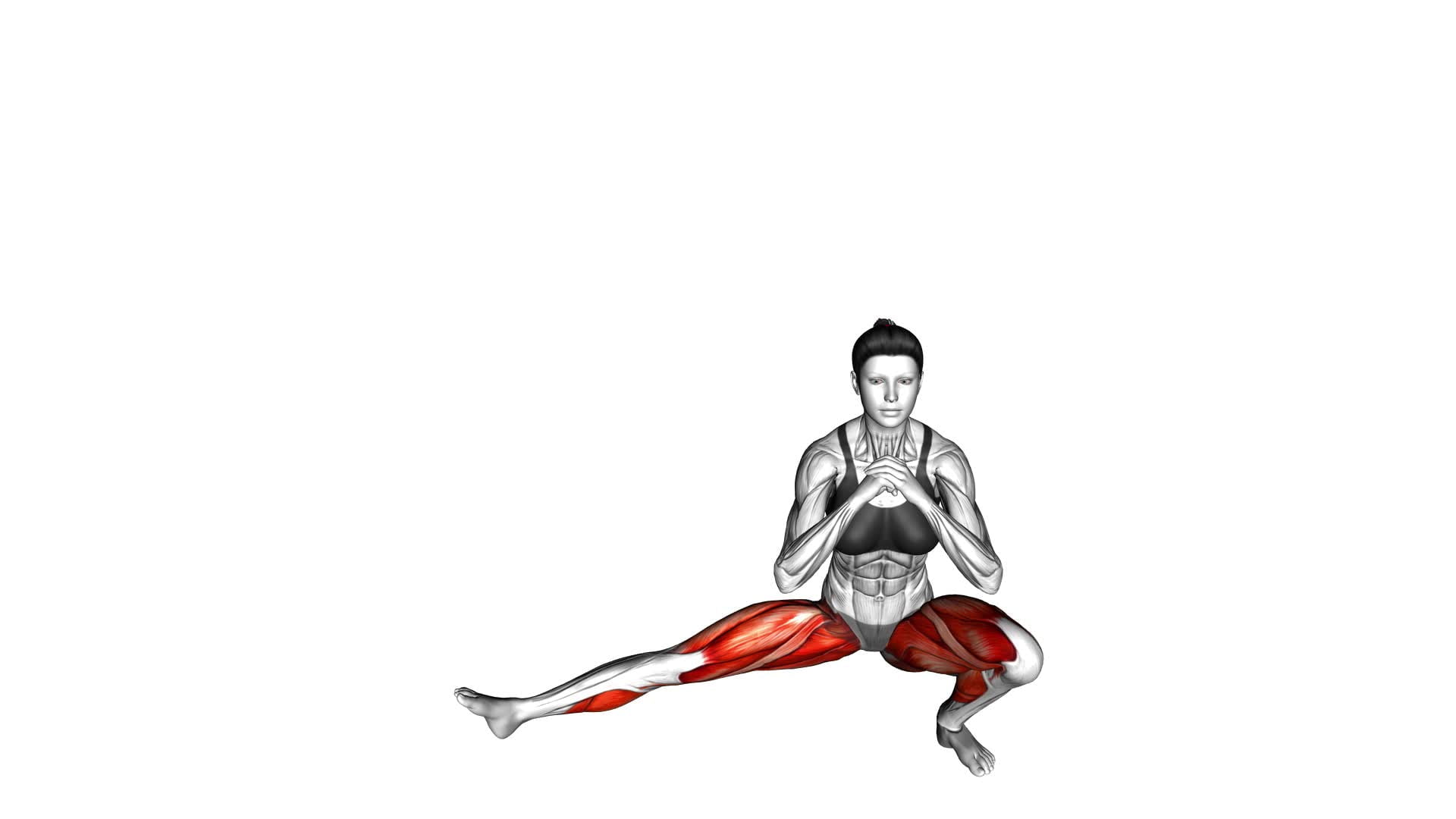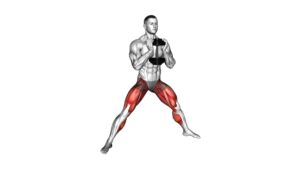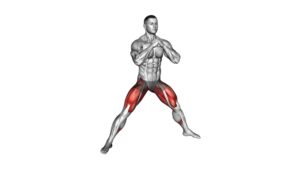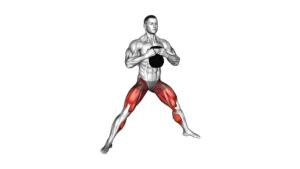Cossack Squats (female) – Video Exercise Guide & Tips

Get ready to strengthen and tone your lower body with Cossack squats!
Watch This Exercise Video
This video exercise guide is here to help you master the proper form and technique.
Whether you're a beginner or a pro, there are variations for every fitness level.
Avoid common mistakes and maximize your results with these helpful tips.
Get ready to feel the burn and transform your legs with Cossack squats.
Let's get started!
Key Takeaways
- Cossack squats engage multiple muscle groups at once, making them an efficient exercise for burning calories and increasing metabolic rate.
- They can aid in weight loss goals and help strengthen and stretch the hip flexors, adductors, and hamstrings.
- Proper form and technique are important, including maintaining a straight back and chest lifted while lowering into a squat position.
- Cossack squats can be modified for different fitness levels, such as using a chair or wall for support as a beginner or incorporating a resistance band for added stability.
Benefits of Cossack Squats
You can experience numerous benefits by incorporating Cossack squats into your fitness routine. Not only are these squats a great way to target your leg muscles, but they also offer additional advantages for weight loss and flexibility.
Cossack squats can be an effective exercise for weight loss because they engage multiple muscle groups at once, helping to burn calories and increase your metabolic rate. By incorporating Cossack squats into your routine, you can boost your overall calorie burn and contribute to your weight loss goals.
In addition to weight loss benefits, Cossack squats are also beneficial for improving flexibility. These squats require a wide stance and deep range of motion, which can help to stretch and strengthen your hip flexors, adductors, and hamstrings. By regularly performing Cossack squats, you can improve your overall flexibility and enhance your mobility in everyday activities.
To reap the full benefits of Cossack squats, it's important to practice proper form and technique. By maintaining a straight back, keeping your chest lifted, and engaging your core, you can ensure that you're targeting the correct muscles and avoiding injury. By transitioning into the section on proper form and technique, you can learn how to perform Cossack squats correctly and maximize the benefits they offer.
Proper Form and Technique
To perform Cossack squats with proper form and technique, it's essential to focus on maintaining a straight back, lifting your chest, and engaging your core. Here are some key points to keep in mind:
- Alignment: Stand with your feet wider than shoulder-width apart and toes pointing out slightly. Keep your back straight and your chest lifted throughout the movement.
- Depth: Lower your body down into a squat position by bending one knee while keeping the other leg straight. Try to go as low as you comfortably can without compromising your form.
- Balance: As you lower into the squat, shift your weight towards the side you're bending, keeping your foot flat on the ground. Maintain your balance by engaging your core muscles.
- Hip mobility: Cossack squats require good hip mobility. Incorporate warm-up exercises such as hip circles and dynamic stretches to prepare your hips for the movement.
By focusing on these correction techniques and incorporating proper warm-up exercises, you can maximize the benefits of Cossack squats while minimizing the risk of injury.
Remember to start with a weight or resistance level that challenges you but still allows you to maintain proper form. With practice and consistency, you'll be able to perform Cossack squats with confidence and reap the rewards they offer for your lower body strength and flexibility.
Variations for Different Fitness Levels
For individuals at different fitness levels, there are various options available to modify Cossack squats. If you're a beginner, it's important to start with variations that are less challenging to avoid strain or injury.
One modification you can try is using a chair or wall for support. Begin by standing with your feet wider than shoulder-width apart, then lower yourself into a squat position while keeping your back straight and chest lifted. Use the chair or wall for balance as needed. This will help you build strength and stability before progressing to more advanced variations.
If you have any injuries or limitations, it's essential to modify the Cossack squats to accommodate your needs. For example, if you have knee pain, you can reduce the depth of the squat or use a smaller range of motion. Alternatively, you can perform the exercise with a resistance band around your thighs to provide additional support and stability.
By modifying the Cossack squats according to your fitness level or injuries, you can still reap the benefits of this exercise while avoiding unnecessary strain.
Now that you have learned about the variations and modifications, let's move on to the next section to discover common mistakes to avoid.
Common Mistakes to Avoid
When performing Cossack squats, it's important to be aware of common mistakes that can hinder your progress.
Focus on correcting your form to maximize the effectiveness of the exercise and prevent injuries.
By following proper technique and incorporating injury prevention techniques such as warming up and stretching, you can ensure that you're getting the most out of your Cossack squats.
Stay motivated and stay mindful of these tips to avoid common pitfalls and achieve your fitness goals.
Form Correction Tips
Correcting form mistakes is essential for performing Cossack squats effectively and preventing injuries. To ensure you get the most out of this exercise and keep yourself safe, pay attention to the following form correction tips:
- Maintain proper alignment: Keep your back straight, chest lifted, and shoulders relaxed throughout the movement. Avoid rounding your back or hunching forward, as this can strain your spine.
- Engage your core: Activate your abdominal muscles to stabilize your torso and maintain balance. This will help protect your lower back and prevent excessive strain on your joints.
- Control your depth: While it's important to challenge yourself, avoid going too low if it compromises your form. Find a comfortable depth that allows you to maintain proper alignment and control throughout the exercise.
- Watch your knees: Ensure that your knees track in line with your toes as you lower into the squat. Avoid letting them cave inward, as this can put stress on your knee joints.
Injury Prevention Techniques
To prevent injuries while performing Cossack squats, make sure to avoid common mistakes that can lead to harm.
One important way to prevent injuries is by incorporating warm-up exercises into your routine. Before starting your Cossack squats, spend a few minutes doing dynamic stretches and movements to warm up your muscles and joints. This will increase blood flow and improve flexibility, reducing the risk of strains or sprains.
Additionally, make sure to maintain proper form throughout the exercise. Keep your back straight, chest lifted, and knees aligned with your toes. Avoid leaning too far forward or letting your knees collapse inward.
Tips for Getting the Most Out of Your Cossack Squats
To get the most out of your Cossack squats, pay attention to your foot placement. Experiment with different angles to target different muscles and find what feels most comfortable for you.
Remember to breathe throughout the movement, inhaling as you lower and exhaling as you rise.
If you want to add more challenge, consider using resistance bands or holding dumbbells for added resistance.
Foot Placement Techniques
To maximize the effectiveness of your Cossack squats, ensure proper foot placement by maintaining a wide and stable stance. Here are four foot placement techniques to help you get the most out of your Cossack squats:
- Parallel Feet: Keep your feet parallel to each other, pointing straight ahead. This variation focuses on working the inner and outer thighs evenly.
- Turned Out Feet: Turn your feet outwards, pointing your toes towards the corners of the room. This variation targets the inner thighs and glutes.
- Heel Lift: Lift your heels slightly off the ground while performing the Cossack squat. This challenges your balance and engages the calf muscles.
- Wide Stance: Take a wider stance than usual, with your feet positioned wider than shoulder-width apart. This variation increases the challenge on your hips and glutes.
Breathing Techniques
Breathe deeply and rhythmically to optimize your performance and maximize the benefits of your Cossack squats. Incorporating proper breathing techniques into your workout routine can enhance your overall experience and help you achieve better results.
When performing Cossack squats, focus on taking slow, deep breaths in through your nose and exhaling fully through your mouth. This will help you stay relaxed and centered during the exercise.
Additionally, you can try incorporating specific breathing exercises and relaxation techniques to further enhance your performance. For example, practicing diaphragmatic breathing or using visualization techniques can help you stay focused and improve your mind-muscle connection.
Adding Resistance Options
To enhance the effectiveness of your Cossack squats, consider incorporating resistance options to challenge your muscles and maximize your workout. Here are four ways you can add resistance to your Cossack squats:
- Resistance Bands: Attach resistance bands around your thighs or ankles to add extra tension and engage your muscles more intensely.
- Dumbbells: Hold a pair of dumbbells in your hands, either at your sides or in a goblet position, to increase the difficulty and work your upper body at the same time.
- Weighted Vest: Wear a weighted vest to add resistance to your entire body, making your Cossack squats more challenging and increasing the workload on your muscles.
- Barbell: Hold a barbell across your upper back, similar to a back squat position, to add significant resistance and target your lower body muscles more effectively.
By incorporating these resistance options, you can take your Cossack squats to the next level and achieve better results.
Now, let's move on to a sample workout routine incorporating Cossack squats.
Sample Workout Routine Incorporating Cossack Squats
After completing the Cossack Squats video exercise guide, you can incorporate them into your workout routine for an added challenge and lower body strength. Here is a sample workout routine that includes Cossack Squats:
- Warm-up: Start with 5-10 minutes of light cardio, such as jogging or jumping jacks, to get your blood flowing and muscles warmed up.
- Cossack Squats: Perform 3 sets of 10-12 reps on each side. Focus on maintaining good form and keeping your chest up throughout the movement.
- Superset: Pair the Cossack Squats with another lower body exercise, such as lunges or glute bridges. Do 3 sets of 10-12 reps for each exercise, alternating between them.
- Progress tracking: To monitor your progress, you can keep a workout journal or use a fitness app that allows you to log your exercises, sets, and reps. This will help you stay accountable and track your improvements over time.
- Cool-down: Finish your workout with some light stretching to help with muscle recovery and prevent soreness.
Frequently Asked Questions
How Many Calories Can You Burn by Doing Cossack Squats?
You can burn a significant amount of calories by doing Cossack squats. This exercise engages multiple muscle groups, including your glutes, quads, and inner thighs, which increases your overall calorie burn.
The more intense and challenging your workout, the more calories you'll likely burn. So, push yourself to go deeper into each squat and maintain proper form to maximize muscle activation and calorie burn.
Keep up the great work!
Can Cossack Squats Help Improve Flexibility?
Cossack squats can definitely help improve flexibility. By incorporating this exercise into your routine, you'll experience increased range of motion in your hips and lower body.
Athletes especially benefit from the added flexibility, as it enhances their performance in various sports.
To get the most out of cossack squats, remember to maintain proper form and technique. Keep your back straight, engage your core, and go as low as you comfortably can.
The benefits are worth the effort!
Are There Any Modifications for Individuals With Knee or Hip Issues?
If you have knee or hip issues, there are modifications you can make to the Cossack squats. Instead of going too low, try a partial range of motion to reduce strain on your joints.
You can also use a chair or wall for support and balance.
Alternatively, you can try other exercises like lunges or step-ups that target the same muscles without putting as much stress on your knees and hips.
How Many Sets and Repetitions Should I Do for Cossack Squats?
To get the most out of your cossack squats, it's important to know how many sets and reps to do. The number of sets and reps will depend on your fitness level and goals.
Start with 2-3 sets of 10-12 reps and gradually increase as you get stronger. Remember to maintain proper form throughout the exercise by keeping your back straight, chest up, and knees aligned with your toes.
Stay committed and you'll see those gains!
Can Cossack Squats Help Improve Balance and Stability?
Cossack squats can definitely improve your balance and stability compared to regular squats. By working your muscles in a lateral and rotational movement pattern, they challenge your body in a different way.
This can be especially beneficial for athletes who need to have strong stability and control in various directions.
Conclusion
Incorporating Cossack squats into your workout routine can provide numerous benefits, including increased lower body strength and improved flexibility. By following proper form and technique, you can effectively target your glutes, quadriceps, and hamstrings.
With variations available for different fitness levels, anyone can benefit from this exercise. Remember to avoid common mistakes and follow the tips provided to get the most out of your Cossack squats.
Start incorporating them into your workouts today for a stronger and more flexible lower body.

Author
Years ago, the spark of my life’s passion ignited in my mind the moment I stepped into the local gym for the first time. The inaugural bead of perspiration, the initial endeavor, the very first surge of endorphins, and a sense of pride that washed over me post-workout marked the beginning of my deep-seated interest in strength sports, fitness, and sports nutrition. This very curiosity blossomed rapidly into a profound fascination, propelling me to earn a Master’s degree in Physical Education from the Academy of Physical Education in Krakow, followed by a Sports Manager diploma from the Jagiellonian University. My journey of growth led me to gain more specialized qualifications, such as being a certified personal trainer with a focus on sports dietetics, a lifeguard, and an instructor for wellness and corrective gymnastics. Theoretical knowledge paired seamlessly with practical experience, reinforcing my belief that the transformation of individuals under my guidance was also a reflection of my personal growth. This belief holds true even today. Each day, I strive to push the boundaries and explore new realms. These realms gently elevate me to greater heights. The unique combination of passion for my field and the continuous quest for growth fuels my drive to break new ground.







